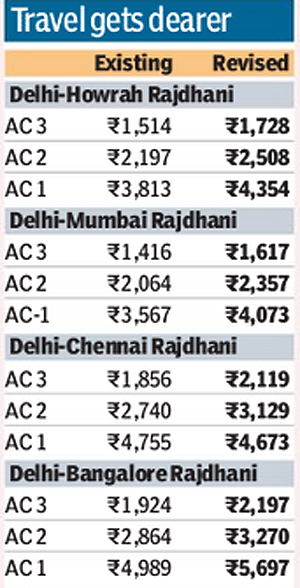Indian Railways on Friday increased passenger fares by a steep 14.2% across classes and freight charges by 6.5% to mop up some R8,000 crore over a year. Prime Minister Narendra Modi had recently talked about taking ?tough decisions and strong measures? aimed at financial discipline, key to economic recovery.
Passenger fares were last hiked (by 20%) in January 2013,ending 10 years of status quo in rates that hit the national transporter?s finances.
As for freight, the six-monthly fuel cost adjustment was reflected in rates in March 2013 and later in October. The UPA government was planning to effect further hikes in passenger fares and freight in May last year but could not do so because the electoral code of conduct came into force.





The new railway minister Sadananda Gowda, after discussing the matter with the prime minister, has allowed the railways to go ahead with the fare hikes even before the presentation of the Railway Budget slated for early July. Friday?s freight hikes include not only the fuel adjustment component (FAC) but additional fare increases over it, although the railways has not given a break-up.
The new fares will take effect from June 25.
Cement, steel and other decontrolled industries that use the railways for transportation of their products have opposed the freight hike, saying it will inflate their costs at a time when demand in the economy is sluggish and they are experiencing severe pricing pressures. The coal industry, the single biggest source (40%) of freight revenue for the railways, is in a relatively better position to pass on the extra cost to consumers due to the lack of competition in the sector, but consuming industries like power and cement, already hit by the strained availability of the fuel, would doubtless resist it.
As for the fertiliser industry, another key user of the railways, the burden of the fare hikes would partly come back to the government as the prices of these products are heavily subsidised by it. An increase in the cost of foodgrain transportation can add to the government?s food subsidy cost.
Sonal Varma, economist at Nomura Research, said, ?The fare hikes will add slightly to inflation in the near term. The rise in passenger fares will add around 10 basis points to CPI inflation, while there will be a limited indirect impact on the CPI from the freight hike. WPI inflation is likely to see a marginally larger impact (the railways accounts for around 35% of freight traffic in India) as the cost of transporting goods such as coal, cement, oil, steel and foodgrains will rise.?
According to SBI Research, Friday?s fare hikes will improve the operating ratio of the railways to 85%, the lowest since FY08. ?The fare hike will, however, impact inflation in the short term but is welcome as it will reduce the cross subsididation of passenger fares from freight,? it said in a report.
The railways, which had reported an operating ratio of 90.4% last year, is expecting freight revenue to come to its rescue this year as passenger volumes have been trending below projections over several months and has even shown a dip lately.
Passenger fares are cross-subsidised by the freight segment (to the tune of R26,000 crore) and needless to say that even with Friday?s fare hike, that would hardly be corrected. The railways is incurring a loss of R900 crore a month in the passenger segment.
The railways? gross traffic receipts for FY15 is projected at R1,60,775 crore. The national carrier expected its passenger bookings to be around 8,800 million in FY15 compared to 8,535 million in the last fiscal.
However, it is already clear that the estimate is unachievable. In April-May 2014 (in any year, these months are normally the peak season for railways), passenger bookings stood at 1,377.82 million compared with 1,396.03 million during the same period a year earlier.
In the interim budget for FY15 presented by the UPA government, the passenger revenue was seen at R45,255 crore, up R7,500 crore over the revised estimate of FY14. It may be noted the revised estimate for last year was 11% lower than the initially budgeted R42,210 crore.
?Freight-wise, we are looking very comfortable as we carried 180.63 million tonnes of revenue-earning freight during April-May 2014, an increase of 8.79 million tonnes over the same period in the last fiscal. Going by the trend, we are expecting that the freight revenue could be higher than the budget estimates,? a railway official had told FE earlier.
?I was forced to implement the order that was done by my predecessor. I am only withdrawing the withholding order,? Gowda said, referring to a May 16 order of the UPA government that was immediately out on hold.
It was the UPA government that began the practice of announcing passenger fare hike outside the Railway Budget when it announced the 20% hike in January 2013.





















